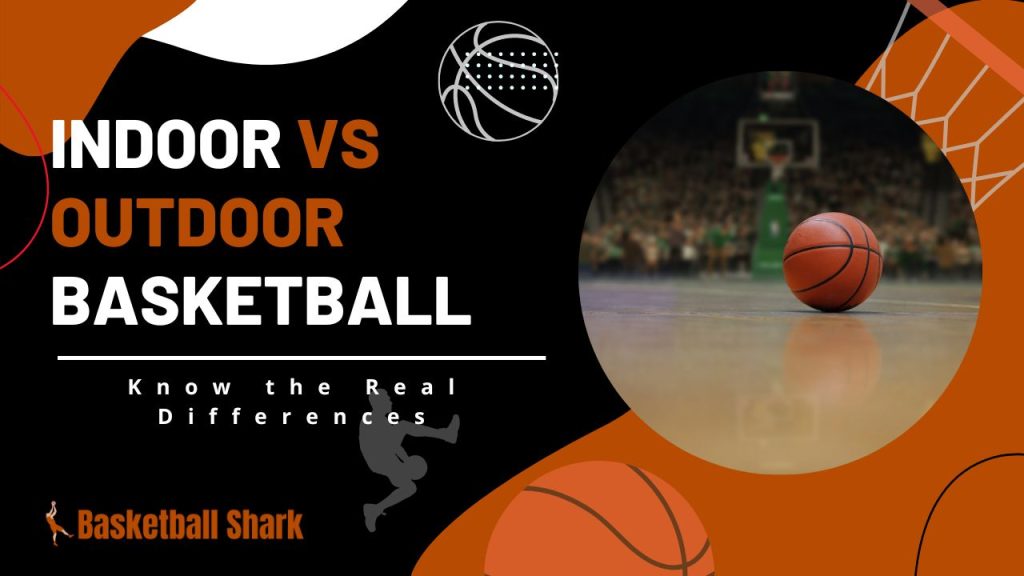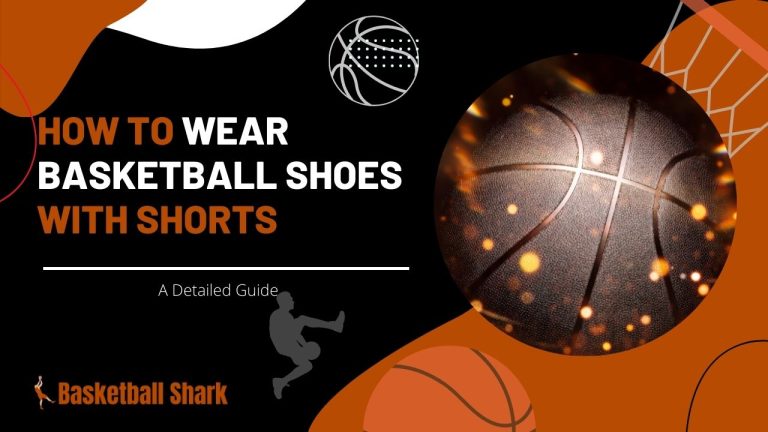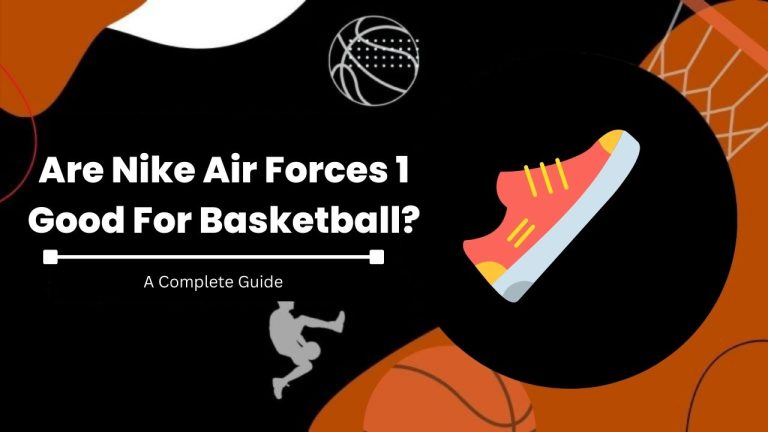Indoor vs Outdoor Basketball – Know the Real Differences
Basketball is slightly different from other sports, as professionals always play it on indoor courts. That is why people often wonder why professional basketball players do not play on outside courts. So, if you are one of those people, we have got you covered.

Here, we will answer this question by highlighting the major differences between indoor and outdoor basketball games. But besides the differences, we will answer some confusions regarding this topic. So, if you are interested in a similar discussion, let’s begin.
Indoor vs Outdoor Basketball Balls – Which One Is Better?
Many basketball players claim that the balls used for indoor basketball games are better than outdoor basketball games. So, to check if their claim is valid, we’ll perform different activities on indoor and outdoor basketballs. But first, let’s see how the balls for indoor basketball games differ from outdoor basketball games.
The major difference between indoor and outdoor basketball balls:
Indoor and outdoor basketballs come in different materials. So, to understand the significant differences between these balls, let’s discuss the different types of basketballs.
1. Composite balls
Composite balls come in two types:
- Game balls
- Practice balls.
Game balls
These types of balls are ideal for indoor courts. For example, you can use it for games or at a competitive team level. But using these balls on pavement will likely kill their lifespan because they have defined pebbles that are strictly meant for smooth surfaces.
Thus, the outdoor usage of composite balls will deteriorate the exterior of these balls much faster because of uneven bumps on the pavement.
Moreover, composite game balls typically range in price from 40-65 dollars because of their quality. But if you are looking for a good quality composite game ball, the ‘Spalding TF-1000’ and the ‘Wilson Evolution’ are ideal choices.
Practice balls
On the other hand, if you want a good indoor ball for practice, you can pick either the ‘Baden Contender’ or ‘Spalding TF-500.’Both of these balls are also composite balls. But they are slightly lower in quality and more affordable than the game balls (Spalding TF-1000 and Wilson Evolution). So, they’re great affordable balls for schools. But at the same time, they are perfect for indoor teams that need them for practice.
2. Rubber balls
Rubber basketballs are suitable for daily outdoor usage, which means you can also use them for recreational purposes. This type of basketball is ideal for walk-in customers looking for a basketball for their kids. Although the price range for rubber balls is around 8-20 dollars, if you want one of the most economical options for a rubber basketball, you can choose ‘Spalding TF-150.’
Most basketball brands offer a rubber basketball option. So, if you like a specific name brand, you will likely be able to get it as a rubber basketball.
3. Leather balls
Leather basketballs are available as an opposite spectrum to rubber balls. These balls are made of genuine leather and provide an excellent grip. That is why they are on the pricier side. But at the same time, these types of basketballs will make a perfect gift for the basketball enthusiasts in your life.
Generally, leather balls typically range between 100-200 dollars. However, like composite balls, you should only use leather balls for indoor usage, as taking them outdoors would drastically decrease the ball’s lifespan. They have incredibly detailed pebbling, which is why they have a fantastic grip.
Some activities on the indoor and outdoor basketballs:
Besides the differences in material, the balls for indoor and outdoor basketball games also differ in gripping, catching, and weight. So, we’ll perform basic basketball testing on each ball to see how indoor vs outdoor basketballs stack against each other.
1. Dribbling
During a short dribbling session with an outdoor ball, we found the handles of the outdoor ball were satisfactory. However, the grip wasn’t there. So, on a scale of 1/10, we assigned 7 points to the outdoor basketball for dribbling.
On the other hand, the ball for indoor basketball straightaway had a much better grip than its outdoor counterpart. The dribbling was good, but it wasn’t perfect. That’s because the center of the mass of the indoor ball was not in the center. It was like having another ball inside the indoor basketball.
Thus, we gave 9/10 to indoor basketball for dribbling.
2. Passing
We first performed the ‘passing’ test on the outdoor ball. During the passing session, we did one-hand passing because any ball could easily pass the two-hand passing test. The catching of the outdoor ball was better than our expectations. Therefore, we gave 9/10 to the outdoor ball for passing or catching.
On the contrary, we assigned a solid 10/10 to the indoor ball for passing. That’s because of the following reasons:
- When we lost control of the indoor ball, we could still catch it easily with our left and right hands.
- Similarly, the palming for the indoor ball was much better than for the outdoor balls.
3. Shooting
The shooting session was challenging for both balls because the wind was blowing when we performed this test. But let’s see how each ball performed in the shooting test.
When it comes to shooting in a basketball game, the ball’s grip doesn’t matter. The only thing that matters is whether you are comfortable with the ball or not. So, the shooting was excellent with the outdoor ball. Hence, we assigned a solid 10/10 to the outdoor ball for shooting.
The indoor ball felt slightly heavier than the outdoor ball during shooting. So, we gave 9/10 for shooting with an indoor ball.
Indoor vs Outdoor Basketball Courts
Like tennis, you can also play basketball on the indoor and outdoor courts. While the rules of the games will not change, some external factors will be different in outdoor basketball games. So, let’s look at those factors.
1. Court material
The major difference between the court of an indoor and outdoor basketball is the court material. Generally, the indoor courts are hardwood-based. Therefore, they offer more cushioning and the basketball’s movement is easier to predict on such court materials.
Moreover, indoor basketball courts are easier on a player’s joints. That is why most professional basketball players play indoor basketball.
Due to the difference in court materials, you will also need different basketball shoes for indoor and outdoor basketball sessions. So, check the ‘Indoor vs Outdoor Basketball Shoes’ section of this guide to get more detail about it.
2. Weather
Weather is another key difference between indoor and outdoor basketball games. For example, despite being indoors, humidity and water can still damage indoor basketball courts.
On the other hand, if you play outdoor basketball, the following factors can affect your game:
- Harsh weather conditions.
- Lighting.
- Wind.
Moreover, weather erosion can also affect outdoor basketball courts. So, whether you play basketball on an indoor or outdoor court, if your court gets damaged, you should seek professional help.
Indoor vs Outdoor Basketball Shoes
Like balls and courts, the shoes for indoor and outdoor basketball games are also slightly different. So, let’s get to the differences between the shoes for playing indoor and outdoor basketball games.
1. Traction
The softer the shoes’ rubber, the better it will be for indoor basketball games. But if you use indoor basketball shoes for outdoor basketball games, the bottom of the shoes will not stick to the pavement well. So, you will slip a lot.
On the other hand, the harder the shoes’ rubber, the better it will be for outdoor basketball games. Such shoes will stick to the pavement better. Undoubtedly, outdoor shoes will also slip on the pavement. But they won’t slip as much as indoor basketball shoes on the outdoor courts.
2. Ventilation
Playing basketball on indoor courts will not be as hot as playing basketball on outdoor courts. So, besides harder rubber, outdoor basketball shoes should have little holes covered by mesh. So, those holes will come in handy for ventilation. This way, you can prevent blisters.
Besides traction and ventilation, everything for outdoor and indoor basketball shoes will be the same. So, when you look in the market for outdoor basketball shoes, you should consider traction and ventilation.
What’s the difference between indoor and outdoor basketball?
The indoor and outdoor basketball games are different from each other in terms of the following thing:
- Basketball court.
- Basketball shoes.
- Ball of the basketball.
So, read the above guide to get the complete detail of the differences between indoor and outdoor basketball games.
Read More:
- Everything About the Hang on Rim Rule You Need to Know!
- Does Basketball Make You Taller?
- Best Indoor Wall Mount Basketball Hoops
- Rebound Basketball Tipped
Final Verdict – The Key Takeaways
According to our quick ‘dribbling,’ ‘passing’ and ‘shooting’ tests, indoor balls are much better than outdoor balls. Undoubtedly, outdoor balls go through challenging scenarios, like rain or concrete. But they are outdoor balls. So, they are supposed to face those scenarios.
On the other hand, indoor balls felt slightly heavier than outdoor balls during shooting. But overall, they offered a better grip and catching was more comfortable in indoor balls.
As far as the shoes for indoor and outdoor basketball games are concerned, there is not much difference between them. The only difference occurs in traction and breathability (ventilation).
You must understand that if you are looking for outdoor basketball shoes, you will need excellent and tough traction at the bottom. This way, your shoes won’t wear out quickly and will last a long time outdoors. Plus, you will need a breathable and ventilated section at the top to avoid blisters in a hot and sweaty basketball game.
Regarding purchasing indoor basketball shoes, some hard tractions work with indoor basketball shoes. But generally, you should look for soft and pliable indoor basketball shoes. Breathability in indoor shoes is not necessary. But it will be a plus point if you get good ventilation for your feet in indoor basketball shoes.
Yes, you can. But there’s a catch to it, as using indoor basketballs on the outside courts will kill their lifespan. That’s because indoor basketballs have defined pebbles that are strictly meant for smooth surfaces. So, using such balls on the outside court will deteriorate their exterior much faster because of uneven pavement bumps.
Like tennis, basketball is both an indoor and outdoor sport. But the materials used to build basketball courts for indoor and outdoor games will be different. Plus, the shoes for indoor and outdoor basketball games will also be different. So, read the above guide to determine indoor and outdoor basketball game differences.
Rubber basketballs are suitable for daily outdoor usage, which means you can also use them for recreational purposes. This type of basketball is ideal for walk-in customers looking for a basketball for their kids. So, one of the most economical options for a rubber basketball Spalding TF-150.’
Indoor and outdoor basketballs are the balls used to play on indoor and outdoor basketball courts. Both types of basketballs are different in terms of the build material. However, check the above guide to determine the best indoor and outdoor basketballs.
Basketball is not only an indoor game, as people also play it on outside courts. However, professional players play basketball on indoor courts because the court’s material is easier for their joints. Plus, external factors do not affect indoor basketball games like outdoor basketball games.
The ‘Spalding NBA Indoor/Outdoor Replica Game Ball’ is the best indoor-outdoor basketball because of its durability, leather, and grip. This basketball is an in-betweener of rubber and a leather ball, as it has the perfect softness and firmness balance.






